#Royal Observatory Greenwich
Text

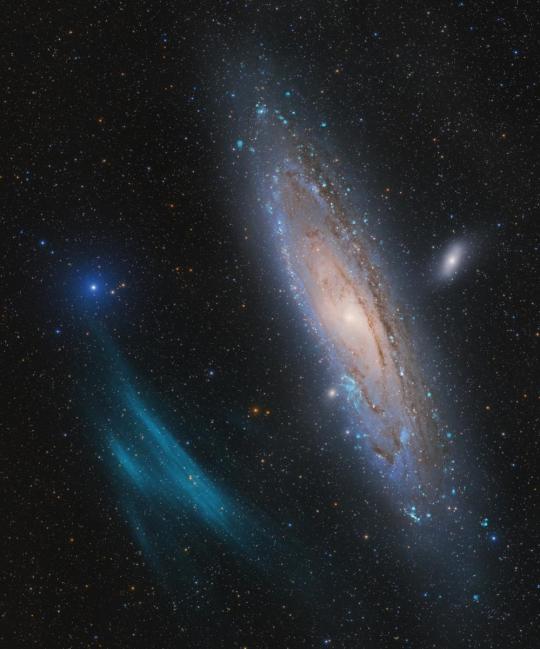
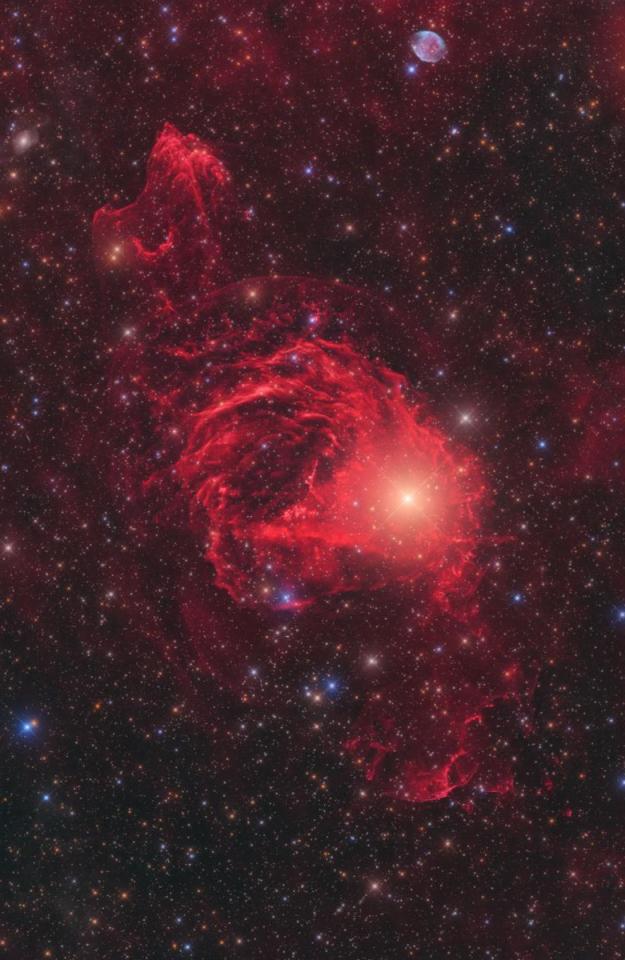



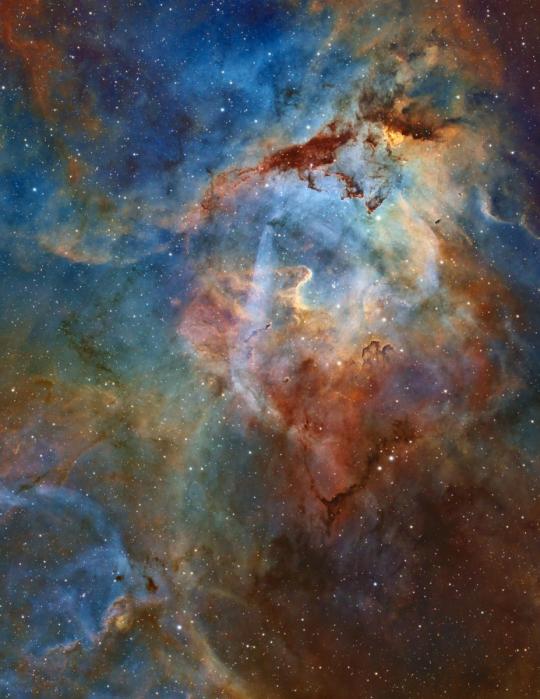


Astronomy Photographer of the Year Award 2023
Brushstroke by Monika Deviat
Andromeda, Unexpected by Marcel Drechsler, Xavier Strottner and Yann Sainty
New Class of Galactic Nebulae Around the Star YY Hya by Marcel Drechsler
Suspended in a Sunbeam by Tom Williams
A Sun Question by Eduardo Schaberger Poupeau
Mars-Set by Ethan Chappel
Sh2-132: Blinded by the Light by Aaron Wilhelm
Grand Cosmic Fireworks by Angel An
The Running Chicken Nebula by Runwei Xu and Binyu Wang
#i literally cried at work while looking at these#like???#the universe is so incredibly gorgeous i can't believe it's real and we are able to look at photographs of it#Astronomy Photographer of the Year Award 2023#apy15#space exploration#Royal Observatory Greenwich#andromeda galaxy#astrophotography#aurora#how are these real#the one of the sun looks so fluffy#running chicken nebula#what a name#space#<3#beauty#art#humanity
10 notes
·
View notes
Photo




...the Great Equatorial Telescope, the UK’s biggest refracting telescope. You can tell from the people around it that it’s a pretty formidable piece of kit. It’s no longer used for serious astronomical research - too much light pollution from London, I assume - but the Observatory does hold public viewing sessions where you can book to come and have a go on it.
I think that’ll do for tonight, so the last lot of photos - from the British Museum today - will have to wait until tomorrow evening.
9 notes
·
View notes
Text
你的明星梦,我的作家老师梦。
比起你的梦:光鲜,靓丽,钱财,社会地位,可以几个月内拔地而起。
而我的梦:多年的知识积累,智慧,技能的累积,可能就只是出个书,没什么一夜的暴富几率。比起做生意,当个作家,老师,还要以身作则,频频教诲,孜孜不倦,十年树木,百年树人。简练的想法,简练的言辞,可以轻而易举的被认为太简单了,我也能想得到。重点在于,第一个想到的就是研发,而后起的可能就模仿。
对于支持的尊重和保护,中西有着本质的差别,一个有研发技能的工程师的待遇,在西方国家就是高级重点重金属,而在亚洲,待遇截然不同。
大家可能觉得偶然,纯是运气之来。偶然在某个时间段,时间点上就很有可能是必然。
我们对于时间空间转换不同世界,不同历史都有很多电影想象。
而我的观点是,偶然很可能就是必然,在那个特定的时间点,事情发生点,人物,地点,特定环境下,所有的参数全部加起来集中的一点历史,就可以推断必然是概率是极大的。
希望所有有知…

View On WordPress
0 notes
Text
Maria Mitchell In Her Own Words
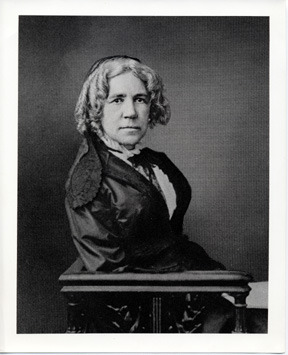
Jan. 11th {1858}. . . . All the early observatories of Europe seem to have been built as temples to Urania, and not as working chamber of science. The Royal Observatory of Greenwich, and the Imperial Observatory of Paris, and the beautiful structure in Calton Hill, Edinburgh, were, at first, wholly useless as Observatories. That of Greenwich had no steadiness, while every pillar in the astronomical temple of Edinburgh, though it may tell of the enlightenment of Greece, hides the light of the stars from the Scottish observer. Well might Struve say that “an observatory should be a simple box to hold instruments.”
Ironically, Maria’s thoughts above would come true for her – the Vassar College Observatory was not built or equipped in the way she would have liked though it was begun before she had agreed to become its director and the professor of astronomy at Vassar. But its important to recognize that sometimes someone can be so caught up in the appearance of something and leaving her or his mark that they don’t take into account how something is really going to be utilized and by whom. So it appears that when built, according to Maria, that these sites were built to be “temples” and to stand out for their beauty, not to stand out for the activity that would happen inside them – and not to be designed with that activity in mind. That is why you need a diverse group to make sure a site is created that is usable – for all.
JNLF
#Nantucket#Maria Mitchell#Nantucket Maria Mitchell Association#Royal Observatory Greenwich#Imperial Observatory of Paris
0 notes
Text
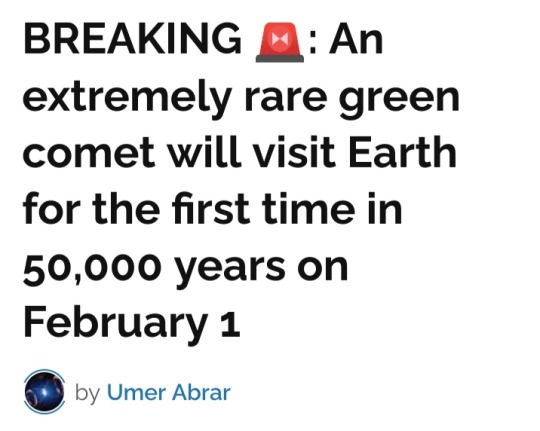
20 January 2023
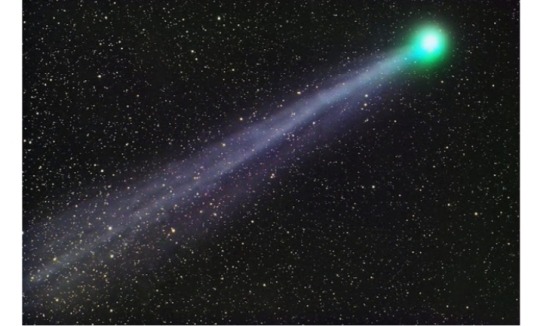
Despite the fact that 2023 has only started, the cosmos are already poised to create history.
A comet that was just recently identified will be visible in a few weeks during what is likely to be its one and only documented appearance.
The comet is expected to have traveled billions of kilometers from its thought beginnings near the fringe of our solar system.
In March 2022, the comet C/2022 E3 (ZTF) was initially seen when it passed through Jupiter's orbit.
It's a long-period comet that NASA believes originated in the Oort Cloud, the furthest area of the solar system, which is described as "like a gigantic, thick-walled bubble formed of frozen chunks of space debris" and may grow to be even larger than mountains.
According to estimates, the inner boundary of this zone is located between 2,000 and 5,000 astronomical units (AUs), or 186 billion and 465 billion miles, from the sun.
This indicates that C/2022 E3 (ZTF) has traveled on a unique, exceptional voyage to be near Earth.

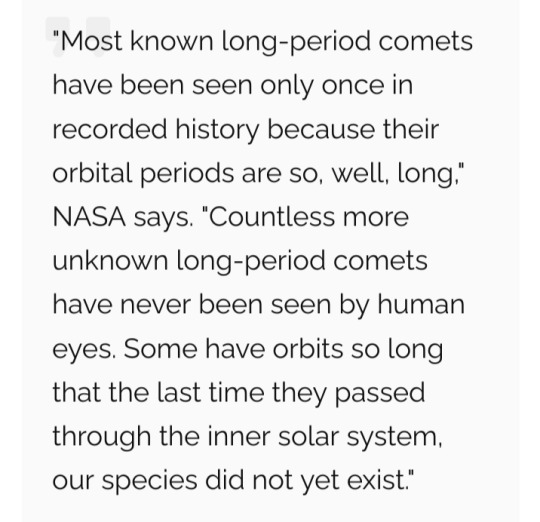
C/2013 A1 Siding Spring, a recent comet of this sort, already visited the inner solar system and passed close to Mars in 2014.
However, the space agency estimates that it won't return for around 740,000 years.
According to Jessica Lee, an astronomer from the Royal Observatory Greenwich, the E3 comet may provide a similar scenario.
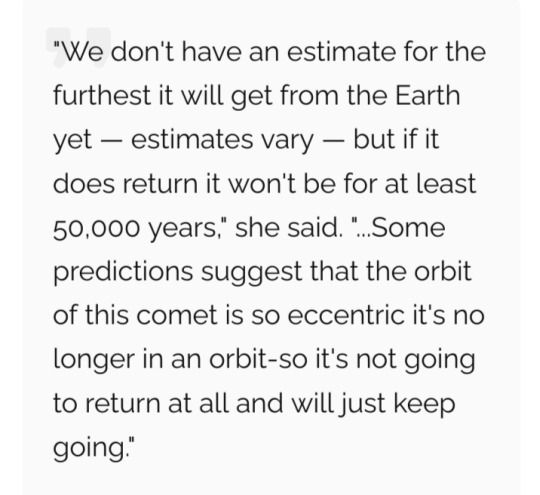
The freshly found E3 comet will now reach its closest approach to the sun on January 12.
It has been seen to have a vivid greenish coma and "short wide" dust tail.
On February 2, it will get as near to Earth as it will.

According to NASA, the comet will be seen with binoculars if everything goes according to plan and its brightness trend continues.
Away from city lights, it could also be seen with the unaided eye. According to NASA, the comet will be visible in the morning hours of January in the northern hemisphere and in the early morning hours of February in the southern hemisphere.
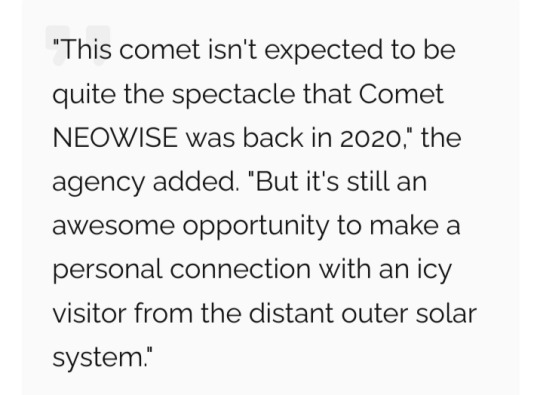

#C/2022 E3 (ZTF)#comet#Oort Cloud#long-period comet#C/2013 A1 Siding Spring#Royal Observatory Greenwich#E3 comet#NASA#astronomy#space
1 note
·
View note
Photo

The red time ball and weather vane on top of Flamsteed House at the Royal Observatory Greenwich.
Two minutes before 13:00 it rises up the pole and then at 13:00 it drops thereby signalling the time to ships on the River Thames below. It first operated in 1833 and has been in operation every since.
#red#time ball#tmeball#observatory#royal observatory#history#time#device#Flamsteed House#13:00#clock#Greenwich#London#England#UK
119 notes
·
View notes
Text
0 notes
Text
I’ve always kind of known that the concept of daylight savings was BS once the whole we-need-more-daylight-to-produce-food-for-soldiers-in-the-Great-War thing was over, but somehow I never realized that even among the countries that do observe daylight savings, fall back/spring forward don’t happen at the same time worldwide.
I’m traveling in the UK and we had fall back last weekend, about which I thought “huh, I don’t remember this happening so close to Halloween before, silly me and my silly memory,” only to come on to Tumblr. Com this weekend to see my dash filled with Cousin Oskar and complaints about the time change and realize we can’t even be bothered to organize one collective alteration to the social construct that is time.
Oh no, we must be spitefully and chaotically individualistic, mustn’t we.
#the Royal observatory in Greenwich really said ‘we are the arbitrary center of space and time’#and then every other country and a couple of random us states decided to cause as many problems as they could#without actively wreaking havoc on international functionality#first person
1 note
·
View note
Text
Hour Zero: Time Starts Here
Hour Zero: Time Starts Here
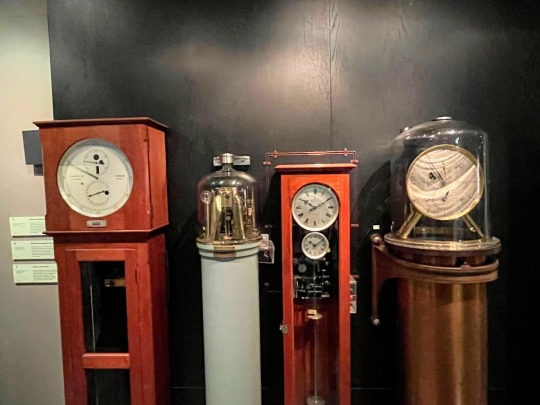
View On WordPress
0 notes
Text

"Andromeda, Unexpected" [photo credit: Marcel Drechsler, Xavier Strottner and Yann Sainty]
The winners of the Royal Observatory Greenwich Annual Astrophotography Competition were announced in Sept 2023.
This year's overall top spot came from the Galaxies category—"Andromeda, Unexpected", titled for the large, blue plasma arc pictured next to our nearest galactic neighbor. The plasma streak is actually a new discovery and is now being studied by scientists as perhaps one of the largest phenomenon of its type anywhere in the known universe.
Winners in other categories include:
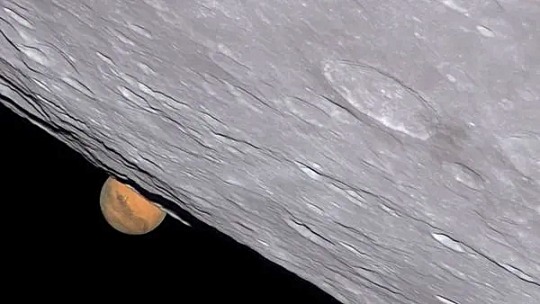
Moon, winner: shows Mars setting behind the Moon's southern hemisphere, shining bright during a rare alignment [credit: Ethan Chappel]

Moon, runner up: the colourful hue that surrounds the moon is a lunar corona formed while bright moonlight is diffracted by water droplets in thin clouds [credit: Miguel Claro]

Aurorae, winner [credit: Monika Deviat]

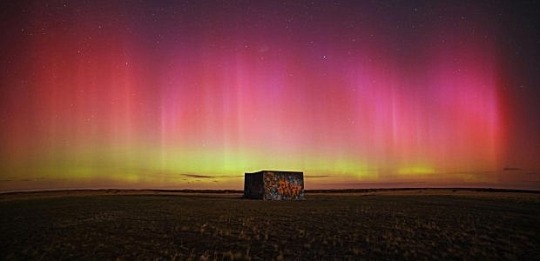
Aurorae, runners up [credit: Andreas Ettl (top) and Chester Hall-Fernandez (bttm)]
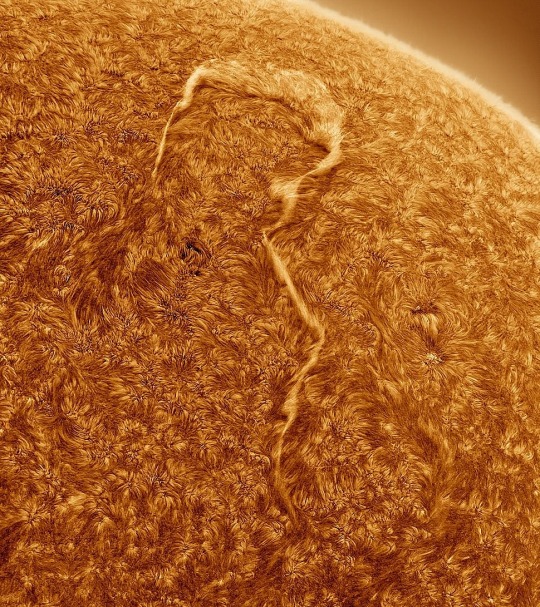
Sun, winner [credit: Eduardo Schaberger Poupeau]
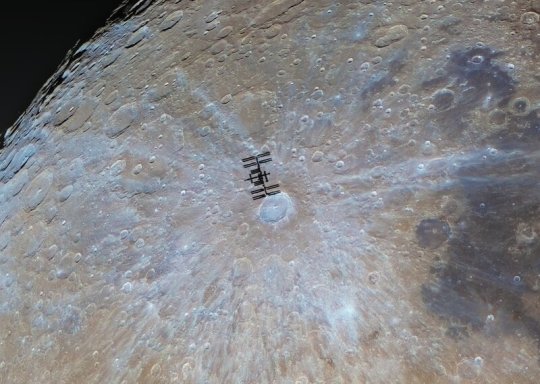
People & Space, runner up: International Space Station [credit: Andrew McCarthy]

Best Young Astronomy Photographer: the Running Chicken Nebula [credit: Runwei Xu and Binyu Wang, both 14 years old]
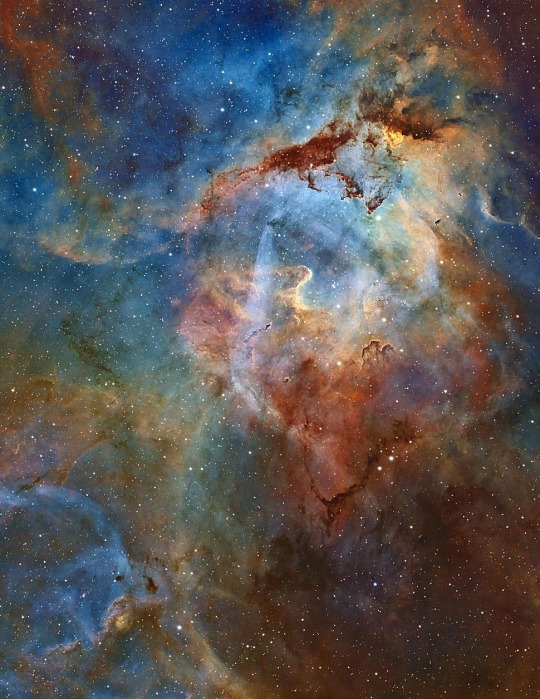
Best Newcomer: Sh2-132 Nebula [credit: Aaron Wilhelm]
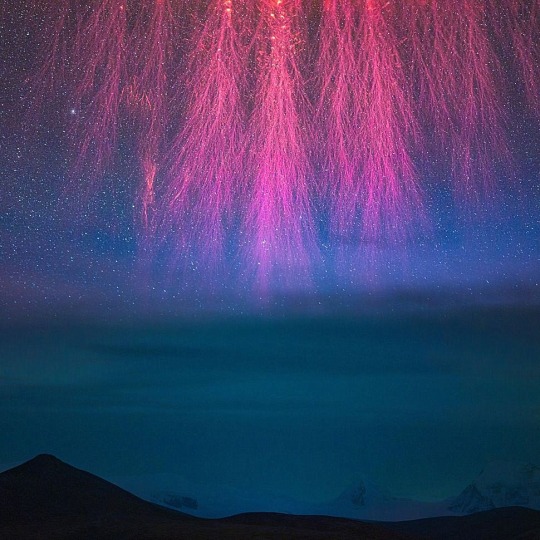
Skyscapes, winner: the extremely rare phenomena captured in this photograph are called sprites. Sprites occur like lightning, high in Earth's atmosphere, and are seldom witnessed from the ground. This photo was taken from an extremely high ridge in the Himalaya mountains of Tibet [credit: Angel An]

Skyscapes, runner up: time-lapse photography of star trails. The movement of the stars in the northern and southern hemispheres both appear to bend away from the stars moving along the celestial equator. [credit: Louis Leroux-Gere] {source: Space.com}
#astronomy#photography#galaxy#nebula#moon#aurora#Mars#sun#cosmos#astrophotography#timelapse#space#stars#nature#science#aesthetic#sky#planets#outer space#beauty-funny-trippy#galaxies#nebulae#solar#sprites#international space station#iss#star trails#Royal Observatory Greenwich#competition
904 notes
·
View notes
Text
David Tennant as a Narrator: DT Goes A Bit Space-y, Pt. 1 - We Are Astronomers (2009)
If you're a fan of David's, you're used to using all sorts of ways to see and hear him perform. You might turn on the television to watch him in shows like Doctor Who or Good Omens. You might flip on your media player of choice to listen to him do sixty-gagillion voices in Cressida Cowell’s How To Train Your Dragon series of audio books, or you might catch him on the radio doing Chase UK bank or Virgin Media adverts. You could even fire up Just Cause 3 or Call of Duty: The Final Reich to catch him in a video game.
But did you know you could also go visit your local planetarium?

David's work as a narrator is just as rich and wide-ranging as all the other aspects of his acting career. So for today and in the following post, we'll take a look at two of these narrative productions connected by a common thread - space.
Come with me back to 2009. It was the International Year of Astronomy (IYA2009), and Edinburgh-based charity Dynamic Earth had received funding from the Science and Technology Facilities Council to partner with a number of UK-based organizations - including the Armagh Planetarium, the Centre For Life, INTECH Science Centre & Planetarium, the National Space Centre, Royal Observatory Greenwich, and Spaceport - to create a 25-minute long 360° full-dome show for planetariums and digital dome theatres called We Are Astronomers.
And it got the then-current Time Lord, David Tennant, to narrate it.....
----
Read further right here on Substack.
Leave comments for me there, or come on back here and tell me what you think!
20 notes
·
View notes
Photo







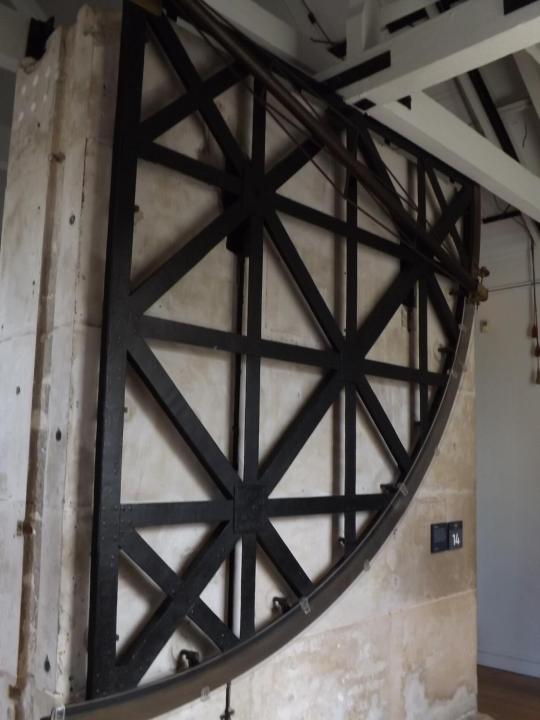
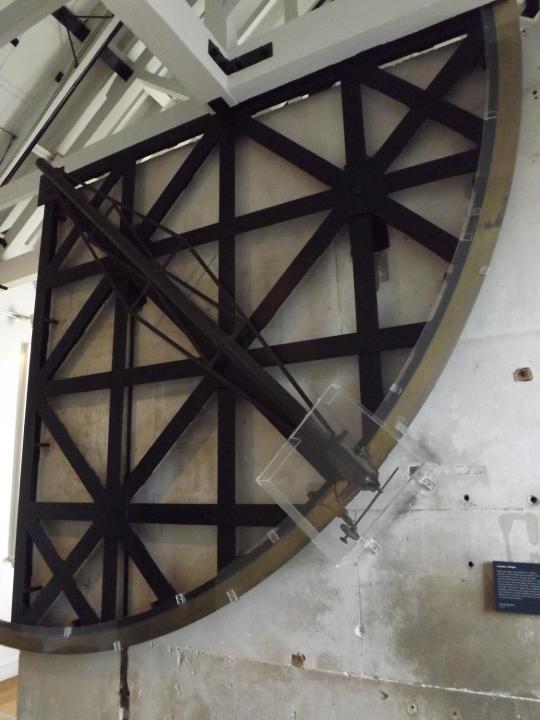

It also houses numerous clocks and astronomical equipment. Including...
3 notes
·
View notes
Text

January 29th 1848 saw the first adoption of GMT by Scotland. The subject has been the source of controversy ever since.
The change had broadly taken place south of the Border from September the previous year with those in Edinburgh living 12 and-a-half minutes behind the new standard time as a result.
The discrepancy grew the further west you moved, with the time in Glasgow some 17 minutes behind GMT. In Ayr the time difference was 18-and-a-half minutes with it rising to 19 minutes in the harbour town of Greenock. All these lapses were ironed out over night on January 29th 1848, but the move wasn’t without controversy as some resisted the move away from local time.
Sometimes referred to as natural time, it had long been determined by sundials and observatories and later by charts and tables which outlined the differences between GMT and local time at various locations across the country. But the need for a standard time measurement was broadly agreed upon given the surge in the number of rail services and passengers with different local times causing confusion, missed trains and even accidents as trains battled for clearance on single tracks.
An editorial in The Scotsman on Saturday, January 28th, 1848, said: “It is a mistake to think that in the country generally the change will be felt as a grievance in any degree. “Probably nine-tenths of those who have clocks and watches believe that their local time is the same with Greenwich time, and will be greatly surprise to learn that the two are not identical. “Even if they wished to keep local time, they want the means.
“Observatories are only found in two or three of our Scottish towns. “As for the sundials in use, their number is small, most of them, too, are made by incompetent persons and even when correctly constructed, the task of putting them up and adjusting them to the meridian is generally left to an ignorant mason, who perhaps takes the mid-day hour from the watch in his fob.” Can you imagine a Mason putting up with being called ignorant in this day and age!
The editorial added: “For the sake of convenience, we sacrifice a few minutes and keep this artificial time in preference to sundial time, which some call natural time, and if the same convenience counsels us to sacrifice a few minutes in order to keep one uniform time over the whole country, why should it not be done!”
Mariners had long observed Greenwich Mean Time and kept at least one chronometer set to calculate their longitude from the Greenwich meridian, which was considered to have a longitude of zero degrees. The move to enforce it as the common time measurement was made by the Railway Clearing House in September 1847.
Some rail companies had printed GMT timetables much sooner. The Great Western Railway deployed the standard time in 1840 given that passengers on its service between London to Bristol, then the biggest trading port with the United States, faced a time difference of 22 minutes between its departure and arrival point.
Rory McEvoy, curator of horology at the Royal Observatory Greenwich, said travel watches of the day had two sets of hands, one gold and one blue steel, to help measure changes in local time during a journey.
Maps also depicted towns with had adopted GMT and those which had not, he added. "There was information out there for determine the local time difference so they would know the offset to apply to GMT before the telegraphic distribution of time.”
Mr McEvoy said different towns and cities in Scotland would have had their own time differences before adoption of GMT. Old local time measurements show that Edinburgh was four-and-a-half minutes ahead of that in Glasgow, for example.
Mr McEvoy added: “I think it is fair to say there was no real concept of these differences at the time. It was when communication began to expand quite rapidly that it became f an issue. I think generally, you would be quite happy that the time of day was your local time.”
In this day in age we takeGMT, for granted, but try and think of how it would have worked in this day and age, and the confusion that would reign!
22 notes
·
View notes
Text
地球儀
地球儀(ちきゅうぎ)globe
北半球(きたはんきゅう)nothern hemisphere
南半球(みなみはんきゅう)southern hemisphere
経度(けいど) longitude
緯度(いど)latitude
経線 (けいせん)meridian
緯線 (いせん)parallel
赤道(せきど)equator
子午線(しごせん)meridian (connecting line of all places that have noon at the same time)
本初子午線(ほんしょしごせん)prime meridian
北緯 (ほくい)north latitude
南緯 (なんい)south latitude
北極(ほっきょく)North Pole
南極(なんきょく)South Pole
北極圏(ほっきょくけん)the Arctic
南極圏 (なんきょくけん)the Antarctic
天文台(てんもんだい)astronomical observatory
東経(とうけい)east longitude
西経(せいけい)west longitude
英訳
If we take a look at a globe, we can see that there are many lines drawn on it. Through these meridian and parallel lines we can point out locations on earth. First, let's take a look at the red line. It is called the equator and is at 0°. Going northward is the nothern latitude; going southward is the southern latitude. At 90° north latitude lies the North Pole. At 90° south latitude is the South Pole. The lines connecting the North and the South Pole are the meridians. The longitude 0° is today a meridian which goes through the Old Royal Observatory in Greenwich, England. From there on, going eastward is the east longitude and going westward is the west longitude. Just like adding the address when we write a letter to a friend, we can use latitude and longitude to indicate a specific location on earth.
#語彙リスト#japanese langblr#japanese language#language learning#jlpt n2#jlpt n1#japanese vocabulary#studyblr#study aesthetic#study blog#studyspo#study motivation#日本語#light academia#dark academia#geography
21 notes
·
View notes
Text
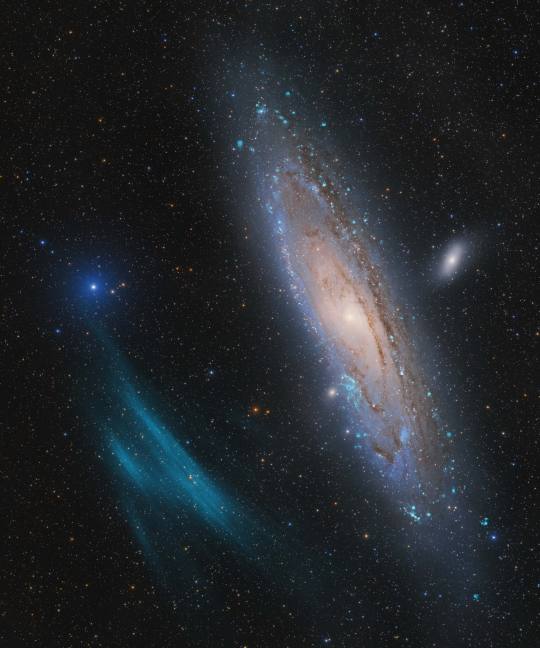
[ A team of amateur astronomers led by Marcel Drechsler, Xavier Strottner and Yann Sainty made a surprising discovery to win the overall prize in the 2023 Astronomy Photographer of the Year competition. "Andromeda, Unexpected" shows a huge plasma arc next to the Andromeda Galaxy, the closest large spiral galaxy to our Milky Way. ]
By: Jess Thomson
Published: Sep 15, 2023
The universe is filled to the brim with weird and wonderful sights, which we are often lucky enough to see thanks to the skills of astrophotographers.
This year's Astronomy Photographer of the Year competition, run by the Royal Observatory Greenwich in the U.K., showcases some of these unique spectacles, ranging from the roaring surface of our sun to our galactic neighbor Andromeda.
Giant Plasma Arc
The overall winning entry of the Astronomy Photographer of the Year 2023, taken by Marcel Drechsler, Xavier Strottner and Yann Sainty, shows the Andromeda galaxy next to an unexpected hazy blue cloud.
This cloud, never before seen, is thought to be an enormous arc of plasma stretching across the space between the Milky Way and our neighboring galaxy, situated 2.5 million light years away.
"What you see is [a] gigantic blue arc of ionised oxygen gas that has never been seen before," amateur astronomer and astrophotographer Drechsler explained in a statement.
This picture reveals how new findings are always being uncovered just under our noses, as we have been observing Andromeda for over 100 years. The reason that the arc—christened the Strottner-Drechsler-Sainty Object 1 (SDSO-1)—had not been spotted before is that it only emitted light in the Oxygen 3 (OIII) wavelength, and was very faint. OIII is a wavelength of light emitted by clouds of oxygen, which only comprise around 1 percent of gas in the universe: hydrogen, by contrast, makes up over 75 percent.
"It was an absolute accident," Drechsler said. "No one expected to see it and that's why it's called Andromeda, Unexpected, because we wanted to take a beautiful image of the Andromeda Galaxy. And we looked at the first data and we spotted this hazy smudge on the edge of the image."
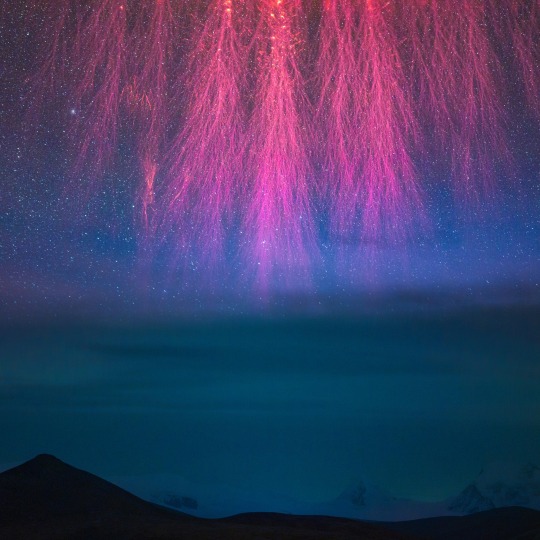
[ Angel An won in the Skyscapes category for snapping the extremely rare phenomenon of Sprites—or red lightning—in which atmospheric luminescence appears like fireworks. "It creates an unsettling, alien image that can't help but draw your eye," said judge Ed Bloomer. ]
Red Sprite Lightning
The winner of the competition's "Skyscapes" category is a spectacular red sprite lightning display, photographed by Angel An.
"Sprites are large-scale, lightning-like discharges that happen above thunderstorms," Caitano L. da Silva, a physics professor at New Mexico Tech, previously told Newsweek.
"They happen in response to powerful cloud-to-ground (CG) flashes in the underlying thunderstorms. These CG flashes radiate a strong electric field that creates sprites at the edge of the lower ionosphere, aka the edge of space," da Silva said. "Sprites are brief, but are huge, 50 km [30 miles] tall by 50 km [30 miles] across, about the size of a small town."
This image was taken at Lake Puma Yumco, in Tibet, China.
"I was standing on the highest ridge of the Himalaya mountains, enjoying the dancing lightning sprites like gorgeous fireworks in the night sky," Angel said. They acted as fairy-like creatures, giving a transient firework show for the audience on Earth. Seeing this extremely rare phenomenon of atmospheric luminescence with such high intensity was something that I have never witnessed before."

[ Eduardo Schaberger Poupeau's photograph of the sun with a huge solar filament in the shape of a question mark won in the Our Sun category. "If you zoom into the surface of the Sun, the image has a paint-like quality—I feel like I can see the brush strokes," said judge Sheila Kanani. ]
Solar Tendrils
The winner of the "Our Sun" category is a close-up of the sun's surface taken by Eduardo Schaberger Poupeau, showing a long tendril of solar plasma.
"This is such a clever image as while we have seen the granulation and surface of the Sun before, I've never seen a filament shaped like a question mark before," Sheila Kanani, competition judge, said in a statement. "If you zoom into the surface of the Sun, the image has a paint-like quality—I feel like I can see the brush strokes. There's a sense of movement and you can almost see the question mark filament moving if you stare long enough."

[ Ethan Chappel won in the Our Moon category for capturing in detail the moon passing in front of Mars on December 8, 2022. Judge Steve Marsh described the occultation as "one of the last and greatest celestial events of 2022." ]
Mars and the Moon
The "Our Moon" category was won by an image of the occultation of Mars by the moon, which is when Mars passes behind the moon in our skies. This image shows Mars as it peeked out from behind our satellite on December 8, 2022, as taken by Ethan Chappel from Texas.
"To capture the level of detail on Mars that you see here takes a huge amount of skill and practice," Steve Marsh, a competition judge, said in the statement. "Combined with a crisp, clear, perfectly processed lunar limb, the result is like taking a gigantic telephoto lens into lunar orbit itself! This image is a technical marvel and a real treat to look at. Two factors which make it a worthy winner in this category."
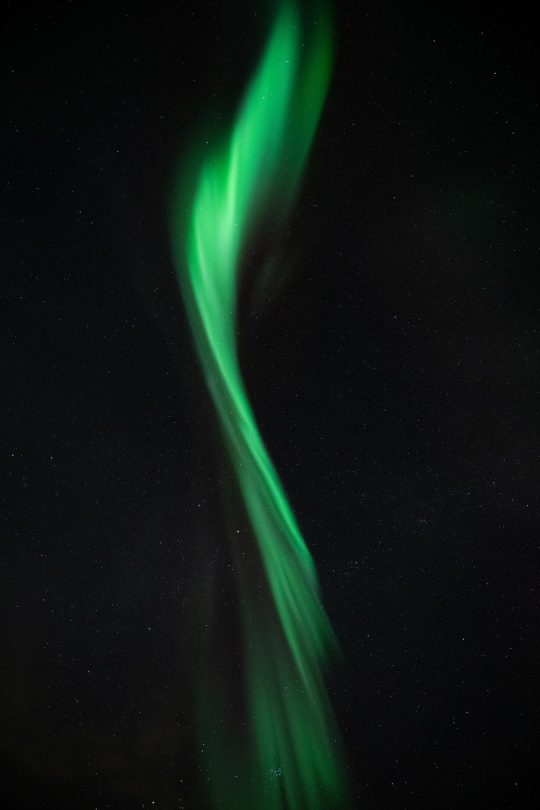
[ Monika Deviat's image of an abstract aurora in the shape of a brushstroke topped the Aurorae category. "We are accustomed to seeing aurora from an earthly perspective with mountains, trees and humanmade structures framing the dancing lights. This photograph offers something different, showcasing the beauty of the aurora in isolation," said judge Katherine Gazzard. ]
Northern Lights
The winner of the "Aurorae" category was of a long flame-like wisp of aurora, taken by Monika Deviat in Finland. Auroras are caused by solar wind slamming into the Earth's atmosphere and magnetic field, causing gases to emit light in the form of the northern and southern lights.
"This photograph is an aurora abstract. I focused on this structure as it looked like a painter's brushstroke across a canvas. It's not the usual corona or big nightscape scene, but I thought it was a unique and beautiful shape with the feathered ends. I pointed the camera almost straight up to capture this formation," Deviat said in a statement.
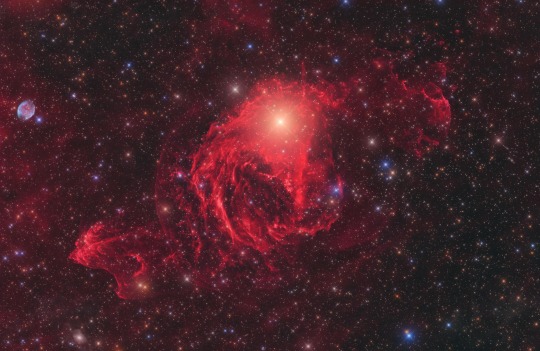
[ A team of amateur astronomers led by Marcel Drechsler, Xavier Strottner and Yann Sainty made a surprising discovery to win the overall prize in the 2023 Astronomy Photographer of the Year competition. "Andromeda, Unexpected" shows a huge plasma arc next to the Andromeda Galaxy, the closest large spiral galaxy to our Milky Way. ]
New Nebula
The winner of the "Stars and Nebulae" category was an image of a galactic nebula around the YY Hya star, taken by Marcel Drechsler from Germany and Xavier Strottner from France over 360 hours of exposure across 100 nights.
This nebula was previously unknown to science.
"In its centre, a pair of stars surrounded by a common envelope was found. For the first time, amateurs and scientists have succeeded in providing evidence for a fully developed shell of a so-called 'common envelope system'," the photographers explain in a statement.
Several other images won their categories, while tens of others filled the longlist and shortlists, all revealing the beauty and mystery of the universe.
"Once again, entrants to the Astronomy Photographer of the Year competition have conspired to make things difficult for the judges, with a flood of high-quality images covering an amazing range of targets. The highlight of this year is perhaps a number of genuine discoveries being imaged, but we've had wonderful efforts in every category," Ed Bloomer, an astronomer at Royal Observatory Greenwich, said in a statement.
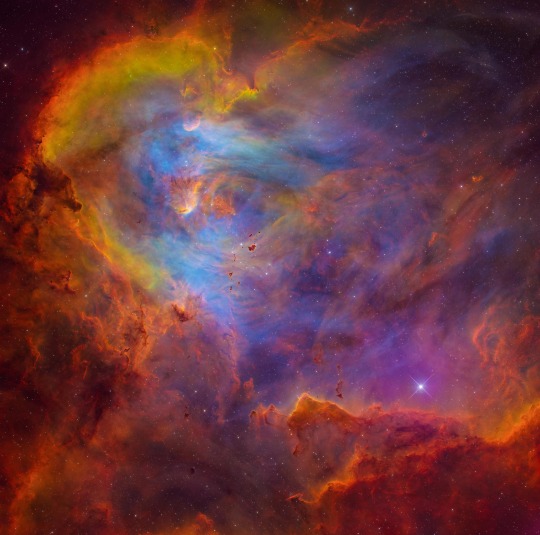
[ The Young Astronomy Photographer of the Year was awarded to two 14-year-old boys from China—Runwei Xu and Binyu Wang—who captured the vibrant colors of the Running Chicken Nebula. The giant cloud of dust and gas is nicknamed that because it looks like a giant chicken running across the sky, according to NASA. ]

[ Tom Williams topped the Planets, Comets & Asteroids category for photographing a unique view of Venus using infrared or ultraviolet false color. "Capturing these atmospheric details from the sunlit side of the planet when it is so far from Earth is a remarkable achievement," said judge László Francsics. ]

[ The Sh2-132 complex lies near the border of the Cepheus and Lacerta constellations and contains multiple deep sky structures. Aaron Wilhelm's winning photograph in the Best Newcomer category includes 70 hours of data and shows the rich interplay of all the gases. ]

[ John White claimed the Innovation prize for capturing the sound of a black hole at the center of the Perseus Galaxy using audio source material from NASA's Chandra Sonification Project and playing it through speakers with a petri dish attached to them. "Here, we are shown an interesting and playful visualisation of astronomical data that we could not 'see' by ourselves nor 'hear'. This is an image of a sound generated by a source that is invisible. Stark, beautiful, rather weird, and certainly innovative!" said judge Ed Bloomer. ]

[ Vikas Chander's photograph of star trails poking through the gray sky above a ship stranded in the treacherous, most northern part of Namibia's Atlantic-facing coast on August 25, 2008, prevailed in the People & Space category. ]
27 notes
·
View notes
Photo

Night time Greenwich
The Queen’s House and the Old Royal Naval College with the Royal Observatory in the background
#Queen's House#Old Royal Naval College#history#royal observatory#night photography#colour#color#Greenwich#London#England#UK
72 notes
·
View notes